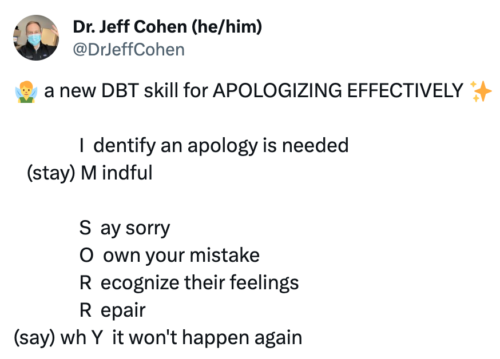- Home
- Resources
- Communication
- Article
How To Apologize Effectively

An effective apology should make you and the other person feel better. Use these 5 steps for how to apologize (plus examples), in order to build an apology that covers your emotional bases.
1. Express Regret
Let the other person know you wish this hadn’t happened, that you know they’re hurting, and that seeing them in pain makes you feel regret. Acknowledge that the situation is bad and that’s not up for debate.
Maybe you need a more subtle version of the above? Try:
- “I know that this isn’t what you expected, and I’m sorry I caused this disappointment.”
- “I wish I’d had the foresight to avoid putting you in this situation.”
- “I can only imagine how annoyed I’d be if I were you, and I regret that I’m at fault.
Notice all of these statements mention something concrete about how the situation feels to the other person.
2. Explain What Happened And Acknowledge The Part You Played
Show you understand exactly what was upsetting and how they see the series of events that brought you here. Validate their perspective, while making sure to mention your role in their perspective. Try to include acknowledgement that you caused the negative emotion they currently feel–even if you didn’t intend to.
A key part of nailing this point is avoiding the dreaded “if.” Good apologies do not include “if,” because it instantly invalidates the other person’s perspective. Use the swaps below for guidance:
- “I’m sorry if I hurt you.” → “I’m sorry I hurt you.”
- “I’m sorry if you felt __________.” → “I’m sorry I made you feel __________.”
- “I’m sorry if it seemed like __________.” → “I’m sorry I made it seem like __________.”
- “I’m sorry if what I said was offensive.” → “I’m sorry that I said something offensive like that.”
Part of effectively apologizing is letting the other person know that you aren’t disputing their negative feeling or why they feel that way. If a person trusts that you understand their perspective, they can more easily trust that this won’t happen again.
3. State Your Remorse and Repent
In addition to expressing regret (that you feel bad for what happened), express that you feel so bad about this, that you feel driven to keep it from happening again. If you could do it over, you would – and in future situations, you will act differently.
- “I’m anxious to keep this from happening again.”
- “I will watch out for similar situations in the future.”
- “I will do all I can to keep this from recurring.”
Bonus points if you can say specifically how you will prevent this from happening again.
4. Offer To Make It Better
Suggest something you could do to make the situation better for the person you hurt. This could include running an errand you made them miss, taking on some chores so they can de-stress, or replacing something of theirs you broke. Anything to either directly repair your mis-step, or to compensate for it.
Not sure how you can make it better? Avoid saying something like “Let me know how I can make it better.” That can make it seem like you haven’t given the matter serious thought (even if you are simply stumped). Instead, try something like:
- If I were in your situation, I might like for me to do _____________. But I understand that an ideal remedy might look different to you.
- I can’t afford to replace _____________ immediately without missing rent. Let’s brainstorm a way for me to lessen the impact on you until I can make things right.
- Without a time machine I can’t change what happened. Instead, what is your ideal path forward? I will do all I can to make that happen.
- Would you be willing to help me find a way to make it better?
5. Ask For Forgiveness
Instead of “I hope that you can forgive me,” shift the burden back from them to yourself.
- “I hope that I will be able to earn your trust again, but understand it may take time.”
- “I will do what I can to remedy this situation, and hope that our relationship can eventually go back to how it was.”
- “Will you please give me a chance to show you this won’t happen again?”
According to research, this is the least important part of a proper apology. This part can be more self-serving than the rest, because an effective apology keeps the focus on what the other person is experiencing, rather than your discomfort. Our view is: do all you can to make things better for the other person, and the forgiveness will probably come without you asking for it.
If you’d like to remember it all more easily, you can take the phrase “IM SORRY” and make it into a DBT-style pneumonic device, as Dr. Jeff Cohen on Twitter suggests:


